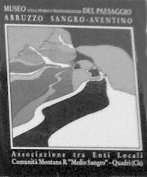|
Torricella Peligna and the Sheep Tracks
There are many reasons which lead us to believe that the
origins of Torricella Peligna might be linked in some way to the
seasonal migration of flocks of sheep from Abruzzo towards the warmer
lands of Puglia: its position in the lee of an ancient sheep track, the
cult of Saint Giacomo, a holy pilgrim, very dear to travellers and in
particular to the shepherds carrying out this transhumance; the very
Church of Saint Giacomo built around AD 1,000; the name of the “Saliera”
Plain, given to an area near to the inhabited zone and not far distant
from the sheep track, (this name probably originates from the custom of
administering salt to the animals in that area); the numerous toponyms
still present in the historic centre which remind us of the various
activities linked to sheep-farming, to the transformation of and the
working of wool. It should be recalled that this territory, in
particular the mountain regions of the Maiella and Monte Pizzi, are
“landing stages” for transhumance and thus stations of arrival and
departure. One should not imagine large herd-filled roads of
disproportionate width, but rather secondary tracks linking with those
further downhill that run along the Adriatic, or those uphill that run
from Ataleta and reach the Molise. In effect, according to some 16th
Century records, the main roads involved in this district flanked the
two rivers, the Sangro and the Aventino, and various little sheep tracks
functioned to connect these together. Amongst the main ones, is the
sheep-track that, forking off from the main Celano-Foggia arm, at the
level of Campo di Giove, crossed the Maiella at the Guado di Coccia, ran
down at Palena and then carried on through Colledimacine, Torricella
Peligna and Roccascalegna; it crossed the Sangro at Ponte di
Sant’Antonio, close by the modern railway station of Bomba and, climbing
towards Monte Pallano and Tornareccio, it came out again at the
sheep-track called
The idea and planning of these articles is by the museum
system: Arc. G. Manzi – Dr. A. Manzi. |

Centurelle-Montesecco. This connection could also
be made at the level of Perano, following the course of the Sangro. In
effect, those who went down by the sheep-track following the banks of
the Aventino, also came out on the main Centurelle-Montesecco
track, which, coming from the direction of Lanciano, crossed the Sangro
at a bridge located between Perano and Atessa. The Bridge of
Sant’Antonio, on the Sangro, was a strategic point from which various
routes spread out, linking the valleys of the Sangro and the Aventino,
involving the territories of Altino, Roccascalegna, Gessopalena,
Torricella Peligna, Lama and Civitella Messer Raimondo. It is likely
that use of some of these routes was subject to payment, as is shown in
the ancient statutes of Altino and Roccascalegna. One had to pay a toll
to cross the Bridge of Sant’Antonio too: in 1620, it yielded an income
of 100 ducats for the feudal lord, although this decreased steadily in
the ensuing years until it became only 25 ducats in 1689, a tangible
sign of the decrease of transit flow.
The routes for the sheep-tracks had probably first been
set out in ancient times, as evidenced by the remains of Italic
fortifications or archaeological sites located along the sheep-tracks.
The strategic importance of these routes, by means of which commercial
and cultural exchanges also took place, was reinforced in later
centuries when dwellings, churches and convents were built alongside the
sheep-tracks.
Produced by: A. Lanci Museum Productions – Lanciano
(Chieti). |